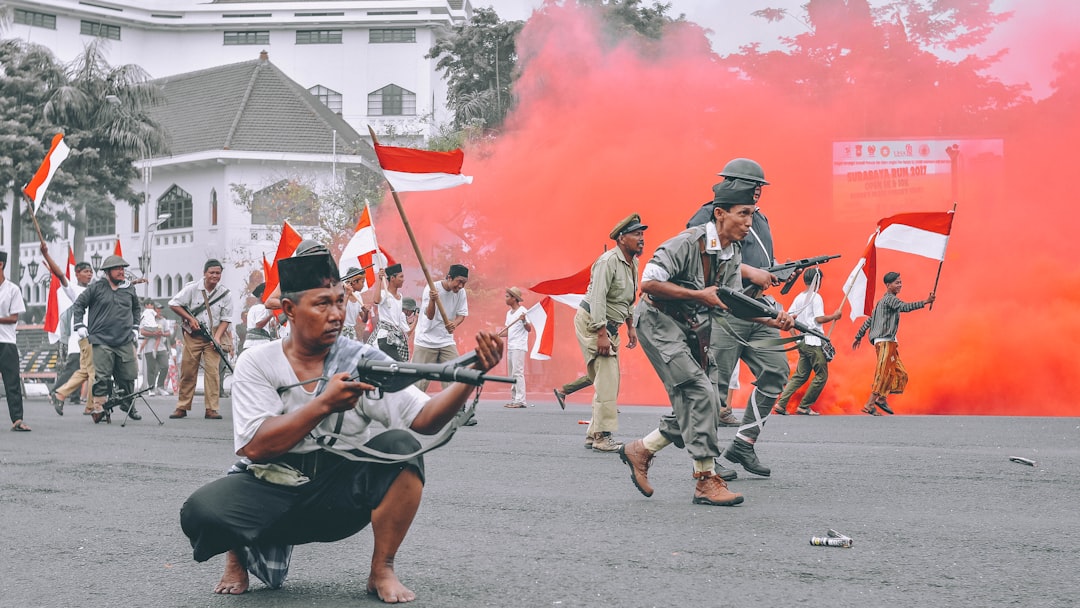The invasion of Kuwait by Iraqi forces on August 2, 1990, marked a significant turning point in Middle Eastern history and international relations. This aggressive act, orchestrated by Iraqi President Saddam Hussein, not only led to a swift military response from a coalition of nations but also set the stage for a prolonged conflict that would reshape the geopolitical landscape of the region. The invasion was characterized by a complex interplay of historical grievances, economic motivations, and political ambitions, all of which culminated in a dramatic confrontation that would have lasting repercussions.
As the world watched in disbelief, the invasion of Kuwait was not merely an isolated incident but rather a culmination of decades of tension and rivalry between Iraq and its smaller neighbor. The event triggered a series of reactions that would engage global powers and lead to a coalition of forces united against Iraq. The ramifications of this invasion extended far beyond the borders of Kuwait, influencing international policies and military strategies for years to come.
Key Takeaways
- Saddam Hussein invaded Kuwait in 1990, leading to a major international crisis and military intervention.
- Iraq and Kuwait had a history of territorial disputes and economic tensions, stemming from the Iran-Iraq War and oil production disagreements.
- Tensions escalated when Iraq accused Kuwait of overproducing oil and not repaying war debts, leading to the invasion in August 1990.
- The invasion of Kuwait by Iraq led to a swift and brutal occupation, with widespread human rights abuses and destruction of infrastructure.
- The international community responded with condemnation and economic sanctions, leading to the United Nations Resolution and Operation Desert Storm to liberate Kuwait.
Background on the Relationship between Iraq and Kuwait
The relationship between Iraq and Kuwait has been fraught with tension since the early 20th century. Following the dissolution of the Ottoman Empire after World War I, both nations found themselves navigating the complexities of colonial mandates and emerging national identities. Iraq, which gained independence in 1932, viewed Kuwait as historically part of its territory, a sentiment rooted in the Ottoman administrative divisions that had existed prior to the war.
This historical claim would later serve as a justification for Saddam Hussein’s aggressive actions. In the years leading up to the invasion, economic factors further strained relations between the two countries. Kuwait’s oil production was a point of contention, as Iraq accused its neighbor of overproducing oil and thus driving down prices, which severely impacted Iraq’s economy, already weakened by the Iran-Iraq War that had concluded in 1988.
The financial burdens stemming from this prolonged conflict left Iraq in dire straits, and Hussein’s regime sought to assert its dominance in the region by targeting Kuwait’s resources.
Events Leading up to the Invasion

In the months preceding the invasion, tensions escalated as Iraq’s economic situation deteriorated. Saddam Hussein’s government sought to leverage its military might to address its financial woes, and Kuwait became an attractive target due to its vast oil reserves. Diplomatic efforts to resolve these issues failed, as Iraq’s demands for debt relief and increased oil prices were met with resistance from Kuwait and other Gulf states.
The failure of diplomacy only heightened Iraq’s sense of desperation and aggression. Additionally, the geopolitical landscape was shifting in the wake of the Cold War. The United States had recently emerged as the world’s sole superpower, and its focus on stabilizing the Middle East created an environment where Hussein believed he could act without significant repercussions.
Miscalculating the international community’s response, he perceived an opportunity to expand Iraq’s influence and secure its economic future through military action against Kuwait.
The Invasion of Kuwait
| Event | Date | Location | Consequences |
|---|---|---|---|
| Invasion of Kuwait | August 2, 1990 | Kuwait | International condemnation, Gulf War, Liberation of Kuwait |
On August 2, 1990, Iraqi forces launched a swift and brutal invasion of Kuwait, overwhelming its defenses within hours. The operation was marked by a combination of ground assaults and aerial bombardments that quickly incapacitated Kuwaiti military capabilities. As Iraqi troops advanced into the capital city of Kuwait City, they faced little resistance, leading to a rapid occupation that shocked the world.
The invasion was characterized by widespread looting and destruction, as Iraqi soldiers pillaged resources and infrastructure. The speed and ferocity of the invasion caught many off guard, prompting immediate condemnation from various nations. The United Nations Security Council convened an emergency session to address the crisis, signaling that the international community would not tolerate such blatant aggression.
As reports of human rights abuses emerged from occupied Kuwait, global outrage grew, setting the stage for a coordinated response against Iraq.
International Response to the Invasion
The international response to Iraq’s invasion of Kuwait was swift and multifaceted. Within days, countries around the world condemned Saddam Hussein’s actions, with many calling for immediate withdrawal from Kuwaiti territory. The United Nations Security Council passed Resolution 660, demanding that Iraq withdraw its forces unconditionally.
This marked a significant moment in international diplomacy, as it demonstrated a unified stance against aggression in violation of international law. In addition to diplomatic measures, countries began mobilizing military resources in preparation for potential intervention. The United States took a leading role in forming a coalition that included nations from Europe, Asia, and the Arab world.
This coalition aimed not only to liberate Kuwait but also to deter further aggression from Iraq. The rapid assembly of forces in the region underscored the seriousness with which the international community viewed Saddam Hussein’s actions.
United Nations Resolution and Economic Sanctions

In response to Iraq’s refusal to comply with UN demands for withdrawal, the Security Council imposed a series of economic sanctions aimed at crippling Iraq’s economy. These sanctions were designed to pressure Saddam Hussein into withdrawing his forces from Kuwait by targeting key sectors such as oil exports and trade. The sanctions had immediate effects on Iraq’s economy, exacerbating existing hardships and leading to widespread suffering among civilians.
The UN sanctions were unprecedented in their scope and severity, reflecting the international community’s determination to hold Iraq accountable for its aggression. However, they also sparked debates about their humanitarian impact. While intended to weaken Hussein’s regime, the sanctions disproportionately affected ordinary Iraqis, leading to shortages of food, medicine, and essential services.
This complex dynamic raised ethical questions about the effectiveness and morality of using economic sanctions as a tool for political change.
Operation Desert Storm and the Liberation of Kuwait
As diplomatic efforts failed to yield results, the coalition forces prepared for military action to liberate Kuwait. On January 17, 1991, Operation Desert Storm commenced with an extensive aerial bombardment aimed at crippling Iraqi military infrastructure and command capabilities. The operation showcased advanced military technology and tactics, including precision bombing and stealth aircraft, which significantly diminished Iraq’s ability to respond effectively.
Following weeks of relentless airstrikes, coalition ground forces launched their offensive on February 24, 1991. The ground assault was characterized by rapid maneuvers and overwhelming force that quickly overwhelmed Iraqi defenses. Within just 100 hours of combat operations, coalition forces liberated Kuwait City and effectively ended Iraqi occupation.
The success of Operation Desert Storm was celebrated worldwide as a triumph of international cooperation against aggression.
Aftermath of the Invasion
The aftermath of the invasion left deep scars on both Kuwait and Iraq. In Kuwait, the liberation was met with jubilation; however, the country faced significant challenges in rebuilding its infrastructure and economy after months of occupation. The physical destruction was extensive, with oil fields set ablaze by retreating Iraqi forces causing environmental devastation that would take years to remediate.
For Iraq, the consequences were dire. The defeat in Kuwait led to further isolation from the international community and intensified internal dissent against Saddam Hussein’s regime. The economic sanctions remained in place for years following the conflict, contributing to widespread poverty and suffering among the Iraqi population.
Additionally, the aftermath saw uprisings within Iraq itself as various ethnic groups sought autonomy or independence from Hussein’s oppressive rule.
Impact on the Middle East Region
The invasion of Kuwait had profound implications for the Middle East region as a whole. It altered power dynamics among Gulf states and heightened tensions between Sunni and Shia populations within Iraq and beyond. The conflict also prompted neighboring countries to reassess their security strategies in light of perceived threats from aggressive neighbors like Iraq.
Moreover, the Gulf War set a precedent for future U.S. military involvement in the region. It established a framework for American presence in Gulf affairs that would continue into subsequent decades, influencing U.
The war also contributed to rising anti-American sentiment among certain groups in the region who viewed U.S. intervention as imperialistic.
Legacy of the Invasion
The legacy of Saddam Hussein’s invasion of Kuwait is multifaceted and continues to resonate today. It served as a stark reminder of the dangers posed by unchecked aggression and authoritarianism in international relations. The conflict underscored the importance of collective security measures through organizations like the United Nations while also highlighting their limitations when it comes to enforcing compliance.
Furthermore, the invasion laid bare issues related to human rights abuses during wartime and raised questions about accountability for war crimes. The experiences gained during Operation Desert Storm influenced military strategies in subsequent conflicts, shaping how nations approach warfare in an increasingly complex global landscape.
Conclusion and Lessons Learned
In conclusion, the invasion of Kuwait by Saddam Hussein was a pivotal event that reshaped not only regional dynamics but also global politics in profound ways. It highlighted both the potential for international cooperation against aggression and the challenges posed by economic sanctions on civilian populations. The lessons learned from this conflict continue to inform contemporary discussions about military intervention, diplomacy, and human rights.
As nations reflect on this historical episode, it becomes clear that vigilance is necessary to prevent similar acts of aggression in the future. The importance of dialogue and diplomacy cannot be overstated; understanding historical grievances can help mitigate conflicts before they escalate into violence. Ultimately, the invasion serves as a cautionary tale about power dynamics in international relations and underscores humanity’s ongoing struggle for peace and justice in an often tumultuous world.
Saddam Hussein, the former President of Iraq, was captured on December 13, 2003, by U.S. forces during Operation Red Dawn. This significant event marked a turning point in the Iraq War, as it led to the eventual trial and execution of Hussein. For more detailed insights into the circumstances surrounding his capture and its implications, you can read a related article on the topic by visiting this page.
WATCH NOW! How the US Hunted and Captured Saddam Hussein: The Untold Story of Operation Red Dawn
FAQs
When did Saddam Hussein capture power in Iraq?
Saddam Hussein became the President of Iraq in 1979 after a power struggle within the ruling Ba’ath Party.
How did Saddam Hussein come to power?
Saddam Hussein initially rose to power within the Ba’ath Party and eventually became the de facto leader of Iraq after a series of political maneuvers and purges of his rivals.
What were the key events leading to Saddam Hussein’s capture of power?
Saddam Hussein’s rise to power was marked by his involvement in the 1968 coup that brought the Ba’ath Party to power in Iraq, as well as his consolidation of power through the elimination of political rivals and dissenters.
What was Saddam Hussein’s rule like in Iraq?
Saddam Hussein’s rule was characterized by authoritarianism, human rights abuses, and the suppression of political opposition. His regime was also marked by conflicts with neighboring countries, including the Iran-Iraq War and the Gulf War.
When was Saddam Hussein removed from power?
Saddam Hussein was removed from power in 2003 following the US-led invasion of Iraq. He was captured by US forces in December 2003 and subsequently tried and executed for crimes against humanity.
